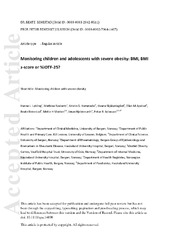Monitoring children and adolescents with severe obesity: body mass index (BMI), BMI z‐score or percentage above the International Obesity Task Force overweight cut‐off?
Løkling, Hanne L; Roelants, Mathieu; Kommedal, Kristin; Skjåkødegård, Hanna Flækøy; Apalset, Ellen M; Benestad, Beate; Morken, Mette Helvik; Hjelmesæth, Jøran; Juliusson, Petur Benedikt
Peer reviewed, Journal article
Accepted version
Permanent lenke
https://hdl.handle.net/1956/20700Utgivelsesdato
2019Metadata
Vis full innførselSamlinger
Originalversjon
https://doi.org/10.1111/apa.14898Sammendrag
Aim: Body mass index (BMI) metrics are widely used as a proxy for adiposity in children with severe obesity. The BMI expressed as the percentage of a cut‐off percentile for overweight or obesity has been proposed as a better alternative than BMI z‐scores when monitoring children and adolescents with severe obesity. Methods: Annual changes in BMI, BMI z‐score and the percentage above the International Obesity Task Force overweight cut‐off (%IOTF‐25) were compared with dual‐energy X‐ray absorptiometry (DXA) derived body fat (%BF‐DXA) in 59 children and adolescents with severe obesity. Results: The change in %BF‐DXA was correlated with the change in %IOTF‐25 (r = 0.68) and BMI (r = 0.70), and somewhat less with the BMI z‐score (r = 0.57). Cohen's Kappa statistic to detect an increase or decrease in %BF‐DXA was fair for %IOTF‐25 (κ = 0.25; p = 0.04) and BMI (κ = 0.33; p = 0.01), but not for the BMI z‐score (κ = 0.08; p = 0.5). The change in BMI was positively biased due to a natural increase with age. Conclusion: Changes in the BMI metrics included in the study are associated differently with changes in %BF‐DXA. The BMI z‐score is widely used to monitor changes in adiposity in children and adolescents with severe obesity, but the %IOTF‐25 might be a better alternative.
